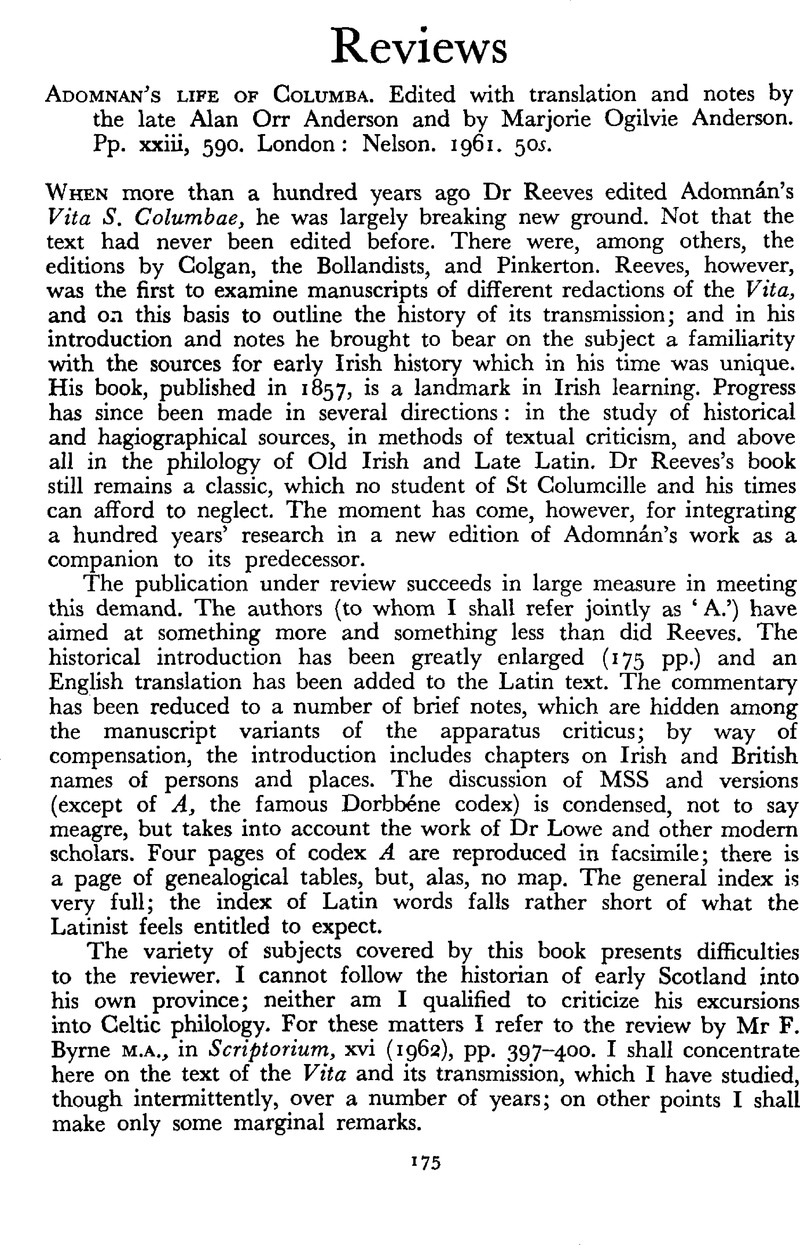No CrossRef data available.
Published online by Cambridge University Press: 28 July 2016

1 Z.C.P., xi. 218 ff., 269 f. Two MSS about which Brüning had no detailed information, viz Paris, Bibl. Nat. lat. 5323, s. XIII, and B.M., Add. 19 726, s. XI1, have been collated by A. If the latter MS came from Tegernsee (‘der Schrift nach sehr gut möglich, jedenfalls süddeutsch’: B. Bischoff in a letter of 31 May 1953), it might be identical with Hardy’s Tegernsee MS ‘s. XIII’ (see Brüning, p. 224).
2 A third MS, B.M., Cott. Tib. D. III, came to Reeves’s notice when his work was nearly completed; he printed its variants in an appendix.
3 One of these, Munich Clm 22 241 (from Windberg, s. XII2), he knew only from the printed edition of Canisius.
4 A., p. 102, unconvincingly make Dorbbéne a bishop of Iona under abbot Dúnchad.
5 So already Brüning, p. 260, n. 1, and especially A., pp. 103-5.
6 The reference to W. M. Lindsay, Palaeographia Latina, ii. 19, is misleading; Lindsay discusses the apex-sign, but not its use as an italicization mark.
7 For editions, see Kenney, Sources, p. 434.
8 So Kenney, l.c. A., p. 10, assume that William was the scribe. This assumption is not borne out by the text of the poem, see esp. lines 22-25. William, no doubt, had entrusted Simeon with the execution of the king’s order. A monk under authority would hardly say of himself qui dignum duxit arare, but he might have thought it right (duxerat œquum) to conclude his work with a poetical prayer.
9 A. state that all three MSS ‘may be descendants of William’s copy’. This seems to me over-cautious.
10 Its existence had been known to James Ussher: P. Grosjean in Anal. Bolland., lxxiii. 196, note.
11 See Brüning, pp. 260 ff., and, with partly new arguments, Mrs A., pp. 12-17, 124.
12 See A., pp. 6 f., 9 f. — A has a set of capitula only before Book I; it does not include the titles of I. 36 and 37 (possibly inserted by Adomnán at a later date) and is incomplete at the end (‘unfinished’: A. p. 7). The capitula of Book I in B 2 (B 1 has none, and the beginning of B 3 is lost) are those of A.
13 A. think these words are necessary, but the transient character of a simultaneous vision of the entire universe is sufficiently expressed by the words in uno eodemque momento.
14 The hounds are not mentioned elsewhere in the story; there was no reason for adding this detail, but an understandable reason for cutting it out.
15 It was later deleted in A.
16 Cf. Hesychius, in Leuiticum 15, 4: doctrinalem … sermonem.
17 So A., p. 7. Their speculations based on the illogical use of enlarged initials in corresponding places in A and B are, however, far from cogent.
18 The Vita s. Columbae in codice (uolumine) I in Saint Gall catalogues s. IX is the shortened version in MS 555: Bruckner, A., Scriptoria Medii Aevi Helvetica III (1938), p. 44 Google Scholar; Lehmann, P., Mittelalterliche Bibliothekskataloge I (1918), pp. 78, 84Google Scholar.
19 This issue has still to be clarified by a full collation of M and more complete collations of the shorter versions than have so far been made.
20 In the case of Irish or Latinized Irish words the accents, even those in B 1 and B 2, have been printed with good reason. A.’s graphic distinction between accents ‘intended to indicate length of vowel’ and those ‘intended to markstress’ (p. 163), however, serves no purpose of documentation.